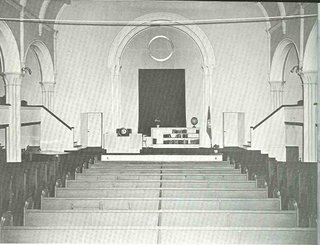

One element of the tremendously exciting experiement in liberal religion known as the Charles Street Meeting House was the transformation of its sanctuary. Its minister, the Rev. Kenneth L. Patton, argued that there are essentially two kinds of religious buildings: the temple and the meeting house. The meeting house is familiar to anyone who's grown up in New England. Largely devoid of any ornamentation, it presents a blank canvass. As Patton wrote in his classic 1964 work A Religion for One World, the meeting house is,
"simply a place of meeting. It is a shelter for fellowship. Its emptiness is to be filled with people and invites the inner quietness of the worshipers. The building says nothing. If anything at all is spoken, it is by the people gathered in it. Its emptiness does not intrude an outer form or dication upon the inner light of the attendent." (pp. 85-86)
The other form of religious structure is the temple. Of this he wrote,
"The temple is just the opposite. It has a central theme or meaning in its dominant architectural symbol, and it is often lavishly decorated with related symbols and art. . . . The temple itself is an expression of a vision of reality and life. . . . [I]nstead of being merely the bare room in which a sermon is delivered, the temple preaches its own sermon through architectural and artisitic voices." (p. 86)
One of the first things Patton and the congregation did was to transform the Charles Street sanctuary from a meeting house into a temple. The totality of this transformation can be seen in these pictures. You can see the pews moved into a circle, surrounding an inlayed imaged of earth, so that the parishioners can see one another and know themselves to be representatives of the whole human race. You can see, too, the painting of the Andromeda Nebula in the apse which was balanced by a mobile of the atom at the other side of the sanctuary, so that the parishioners know their place in the cosmos as between the atom and the stars. The altar is a bookcase, filled with the world's scriptures, poetry, philosophy, and science. Adorning the walls are symbols of humanity's strivings, and art reflecting humanity's yearnings. Truly a temple of a "universalized Universalism."
The Unitarian Universalist Association sold the Charles Street Meeting House in the late 1970s. Today it houses not a worshiping congregation but offices and shops. This temple is no more. Yet the vision lives on, not just in congregations like the First Unitarian Society of Schenectady, NY but also in every congregation that prominently displays the symbols of major world religions. There was more to it all than this, of course, and I plan to come back to Patton and his vision in the days and weeks to come.
In Gassho,
Rev. Wik
[P.S. -- For more information on Patton and the Meeting House you can check out Kennan Pomeroy's research paper: Kenneth L. Patton: A Citizen of the World.]
Print this post
No comments:
Post a Comment